Blog & Latest Updates
Fly Fishing Articles
Insects by Common Name


Stonefly Species Calineuria californica (Golden Stone)
Taxonomic Navigation -?-
Kingdom
Animalia (Animals)
» Phylum
Arthropoda (Arthropods)
» Class
Insecta (Insects)
» Order
Plecoptera (Stoneflies)
» Family
Perlidae (Golden Stones)
» Genus
Calineuria (Golden Stones)
» Species californica (Golden Stone)
Common Names
| Match | Common Name |
| Golden Stone | |
| Western Stonefly | |
| Big Golden Stone |
This large stonefly is ubiquitous in western freestones and can provide incredible angling at ther height of their activity. On rivers lacking populations of Pteronarcys californica, they are the largest and most significant hatch of the year. They are generally a late spring/early summer emerger. They crawl out of the water to perch on streamside riparian foliage or rocks where they shed their nymphal shucks (
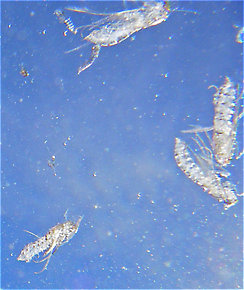
Here's an underwater view of the pupal shucks of several already-emerged Brachycentrus numerosus caddisflies.
The nymphs lack anal gills which easily separates them from Hesperoperla and Claassenia. Their lateral (Lateral: To the side.) ocelli (
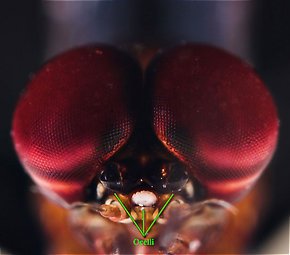
The ocelli of a male Isonychia bicolor mayfly spinner.
The male adults of Calineuria and Hesperoperla are easy to tell apart by looking at their hammers (Hammer: A smooth clearly defined chitinous area on the ventral surface of the ninth abdominal segment of some male stoneflies used for drumming up mates.). Both are quadrangular but Calineuria is longer than wide. The heads and pronotums of both sexes are dramatically marked in Calineuria while Hesperoperla is more plain.
Where & When
Region: West
Time Of Year (?): Late Spring, early Summer
Pictures of 4 Stonefly Specimens in the Species Calineuria californica:
Female Calineuria californica (Golden Stone) Stonefly Adult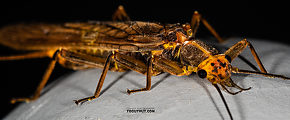 View 17 PicturesI caught this female in the vegetation on a trail about 50 feet above the stream. The coloration on its head differs from that of a male I collected recently on a nearby river, and from another female I collected on the same river. But it still keys out confidently to Calineuria, and californica is the only species of that genus in the area.
View 17 PicturesI caught this female in the vegetation on a trail about 50 feet above the stream. The coloration on its head differs from that of a male I collected recently on a nearby river, and from another female I collected on the same river. But it still keys out confidently to Calineuria, and californica is the only species of that genus in the area.
 View 17 PicturesI caught this female in the vegetation on a trail about 50 feet above the stream. The coloration on its head differs from that of a male I collected recently on a nearby river, and from another female I collected on the same river. But it still keys out confidently to Calineuria, and californica is the only species of that genus in the area.
View 17 PicturesI caught this female in the vegetation on a trail about 50 feet above the stream. The coloration on its head differs from that of a male I collected recently on a nearby river, and from another female I collected on the same river. But it still keys out confidently to Calineuria, and californica is the only species of that genus in the area.Collected July 25, 2019 from Mystery Creek #249 in Washington
Added to Troutnut.com by Troutnut on July 26, 2019
Added to Troutnut.com by Troutnut on July 26, 2019
Male Calineuria californica (Golden Stone) Stonefly Adult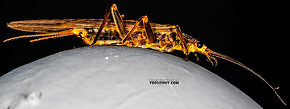 View 15 PicturesA few of these larger stoneflies were fluttering around the South Fork on an evening dominated by much smaller species.
View 15 PicturesA few of these larger stoneflies were fluttering around the South Fork on an evening dominated by much smaller species.
This one has been difficult to identify. I can't spot any of the gill remnants characteristic of Perlidae, but the wing venation (Venation: The pattern in which the veins on the wings of an insect are arranged. It is usually one of the most useful identifying characteristics.) seems to point in that direction. I tried keying it out as Perlodidae but arrived at Isoperla, every western species of which has significantly smaller bodies than this one.
Edit: See forum comments for a likely correct identification.
 View 15 PicturesA few of these larger stoneflies were fluttering around the South Fork on an evening dominated by much smaller species.
View 15 PicturesA few of these larger stoneflies were fluttering around the South Fork on an evening dominated by much smaller species.This one has been difficult to identify. I can't spot any of the gill remnants characteristic of Perlidae, but the wing venation (Venation: The pattern in which the veins on the wings of an insect are arranged. It is usually one of the most useful identifying characteristics.) seems to point in that direction. I tried keying it out as Perlodidae but arrived at Isoperla, every western species of which has significantly smaller bodies than this one.
Edit: See forum comments for a likely correct identification.
Collected July 20, 2019 from the South Fork Snoqualmie River in Washington
Added to Troutnut.com by Troutnut on July 22, 2019
Added to Troutnut.com by Troutnut on July 22, 2019
Calineuria californica (Golden Stone) Stonefly Nymph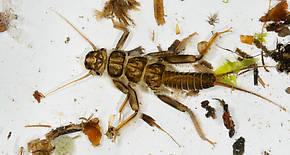 View 1 Pictures
View 1 Pictures
 View 1 Pictures
View 1 PicturesCollected August 9, 2011 from the Touchet River in Washington
Added to Troutnut.com by Bnewell on August 9, 2011
Added to Troutnut.com by Bnewell on August 9, 2011
Your Thoughts On Calineuria californica:
Top 10 Fly Hatches
Top Gift Shop Designs
Eat mayflies.
Top Insect Specimens
Miscellaneous Sites
Troutnut.com is copyright © 2004-2024 Jason
Neuswanger (email Jason). See my FAQ for information about use of my images.
 privacy policy
privacy policy
